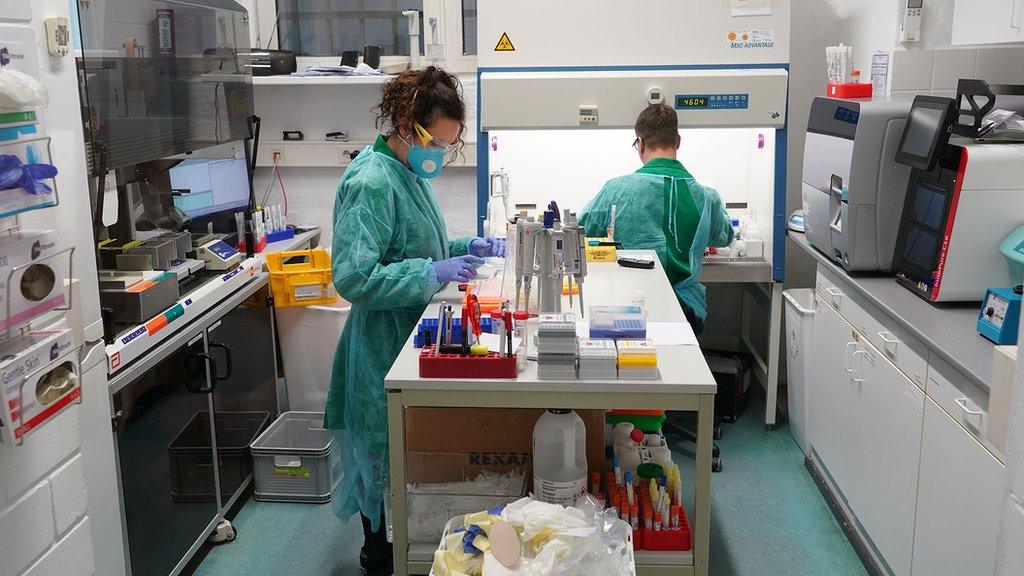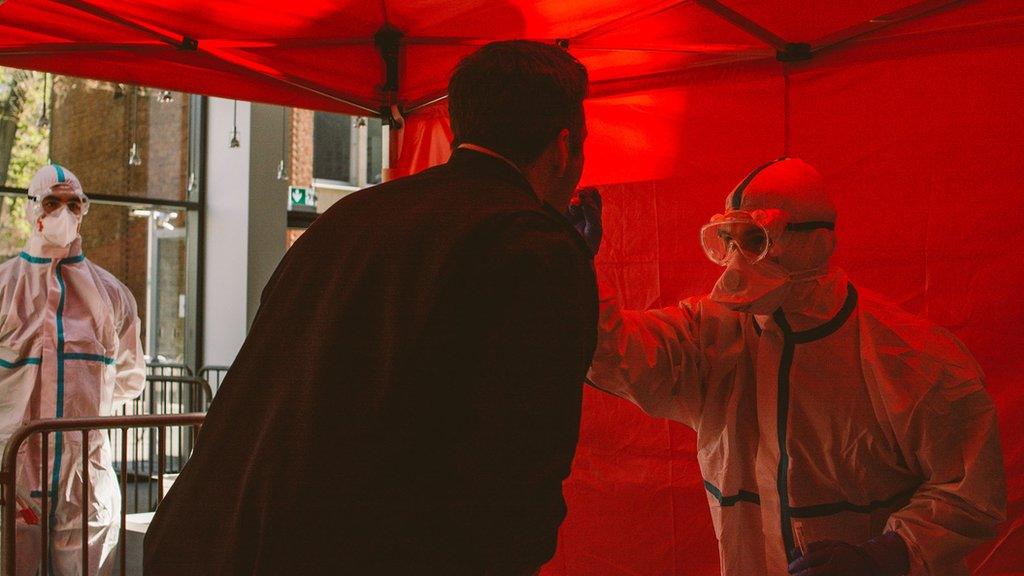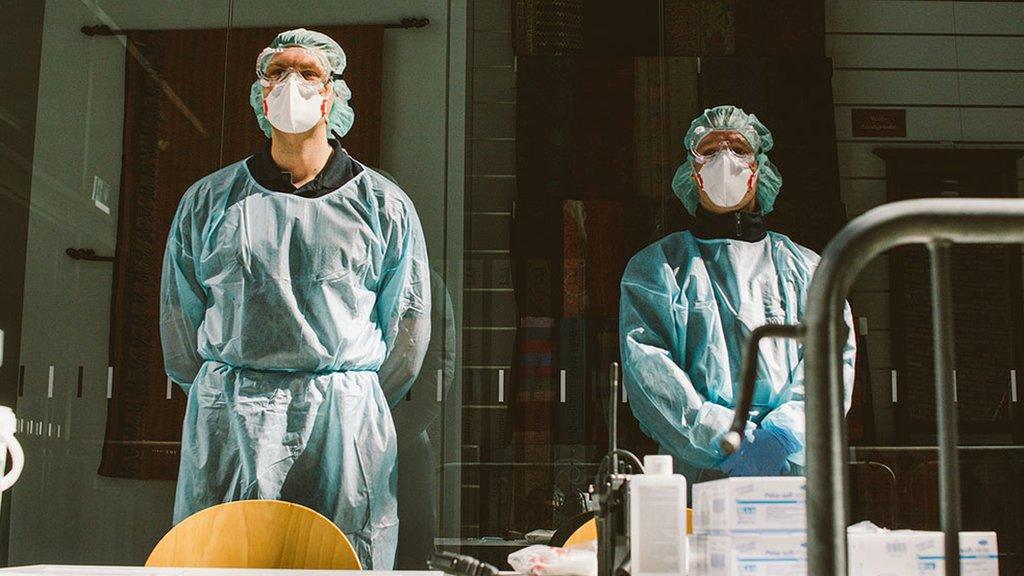Coronavirus: What can the UK learn from Germany on testing?
- Published

Soldiers test people for coronavirus symptoms, in Saarbruecken
Germany is preparing to start new tests next week to find out who has already had the coronavirus. The tests will look for antibodies in the blood, with the aim of working out infection rates.
They will focus initially on blood donations and four areas of the country worst hit by the outbreak.
The trial is a reminder that, when it comes to testing, Germany has been significantly ahead of other European countries, including the UK.
How much more testing has Germany carried out?
The Germans have carried out far more diagnostic swab tests, to establish whether an individual is currently infected with the virus, than other major European countries, such as the UK and France.
In the week ending 4 April, 132 laboratories across Germany carried out an average of 54314 swab tests per day with the capacity to do 116,655 tests per day.
And the total number of swab tests done by 4 April was well over 1.3 million.
The UK, by contrast, is hoping to reach 100,000 tests a day by the end of the month.
As of 10 April, the cumulative UK total stood at 316,836 tests.

"We all know that Germany got ahead in terms of its ability to do testing for the virus and there's a lot to learn from that," said the UK government's chief medical adviser, Chris Whitty, on 7 April.
One thing is clear: if you test a lot, you're also going to be testing a lot of people who don't have the virus or who have only mild symptoms. So, statistically, your death rate will look a lot lower than if you test only people who are already ill in hospital.

Technicians test patient swabs for coronavirus infection, in Berlin
What has Germany been doing differently?
Widespread testing at the start of the outbreak meant many positive cases were identified at an early stage.
And that gave the authorities the chance to trace anyone who had been in contact with infected individuals, to try to slow the spread of the virus.
"People were asked very early a month ago to remain isolated," German Association of Accredited Laboratories spokesman Evangelos Kotsopoulos told BBC News.
"The people [they were in contact with] were also traced and tested repeatedly and they were isolated as well."
Mr Kotsopoulos believes the swift action of the German authorities may have saved lives.
"I think that is the case," he said, "they have managed to flatten the curve a bit and slowed down the rate of infection."
In other words, the number of serious cases, and the number of fatalities, did not rise as quickly as in many other European countries.
"Flattening the curve" is the strategy being followed by many countries, including the UK, to avoid a huge peak in coronavirus cases overwhelming health systems.

A coronavirus testing centre in Cologne's Rautenstrauch Joest museum
Germany certainly has had a relatively low fatality rate - but that could still change.
Many of the early tests were of younger people, most of whom are less vulnerable to the virus.
But there have been signs in the past few days the fatality rate is increasing - and it could yet spike as it has elsewhere.
As of 10 April, Germany had 113,525 confirmed cases and 2,373 deaths, according to the Robert Koch Institute, the country's leading public health body.
And if Germany does end up with a lower fatality rate than other countries in Europe, early testing will be seen as a key factor.
How was Germany able to ramp up testing so quickly?
Health Secretary Matt Hancock has suggested the strength of the German pharmaceutical and biotech industries was a big factor.
Defending the UK's limited testing, compared with Germany, he said: "We have the best scientific labs in the world but we did not have the scale.
"My German counterpart, for instance, could call upon 100 testing labs ready and waiting when the crisis struck, thanks in large part to Roche, one of the biggest diagnostic companies in the world."
But industrial strength may not be the main reason behind Germany's success.
Many of the private laboratories being used for testing in Germany are associated with universities and other medical facilities rather than with big business (and Roche is actually a Swiss company).
More significant may be higher health spending:
Germany spent €4,271 (£3,744) per person on healthcare (11.1% of gross domestic product - the value of goods and services produced in the country) in 2016
The UK spent €3,566 per person on healthcare (9.7% of GDP) in 2016
Germany's federal political system appears to be a big factor too.
It devolves power over large areas of health policy - including testing - away from central government to state level and below.
And that has created more autonomy and flexibility, allowing private labs to start testing far more quickly than in the UK.

A coronavirus testing centre in Cologne's Rautenstrauch Joest museum
By contrast, government agencies in the UK, such as Public Health England, were initially advising mass testing at an early stage would be extremely difficult to achieve.
The British government also took some time to decide a rapid increase in testing should become a policy priority. It was only on 2 April that a plan to ramp up testing significantly was announced, external.

Bonn's DHL Post Tower illuminated to thank workers during the coronavirus crisis
Could or should it have been done earlier? Other international comparisons suggest mass testing is an integral part of the fight against coronavirus.
The more information you have about who has the virus, the more likely an outbreak can be kept under some sort of control.
In East Asia, the country that implemented the most aggressive early testing regime was South Korea. Its "trace, test and treat" strategy has managed to keep the number of diagnosed cases remarkably low.
And, like Germany, its fatality rate is also significantly lower than other comparable countries.

A SIMPLE GUIDE: How do I protect myself?
AVOIDING CONTACT: The rules on self-isolation and exercise
LOOK-UP TOOL: Check cases in your area
This piece was corrected on 12 June to clarify that in the week ending 4 April German labs had the capacity to carry out 116,655 tests per day but actually performed 54,314 tests per day.
